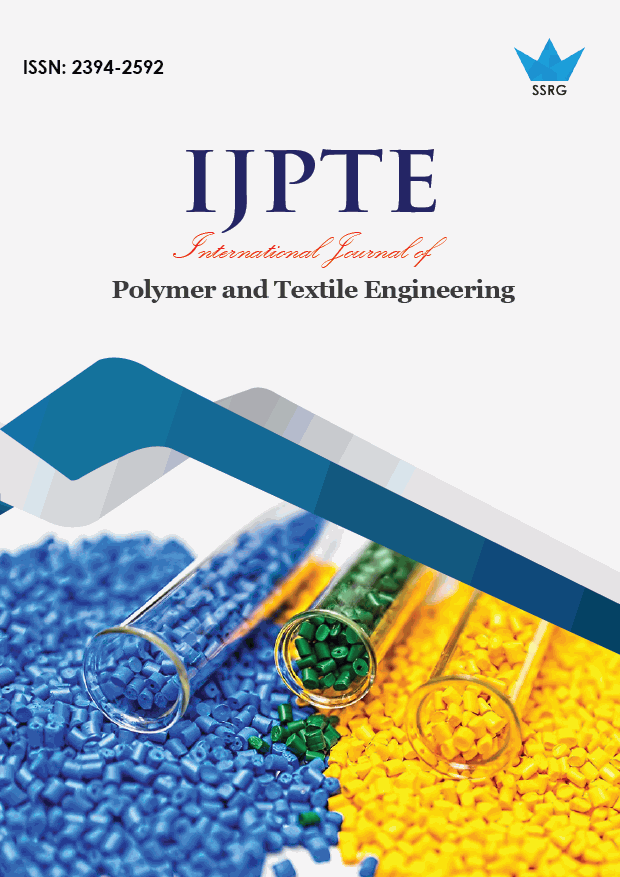Furnishing of Bio Plastics from the Agrobased Polymer and Thermoplastic Strach Based Materials

| International Journal of Polymer and Textile Engineering |
| © 2014 by SSRG - IJPTE Journal |
| Volume 1 Issue 1 |
| Year of Publication : 2014 |
| Authors : S.Ganesh, Dr.B.Bhavana |
How to Cite?
S.Ganesh, Dr.B.Bhavana, "Furnishing of Bio Plastics from the Agrobased Polymer and Thermoplastic Strach Based Materials," SSRG International Journal of Polymer and Textile Engineering, vol. 1, no. 1, pp. 1-3, 2014. Crossref, https://doi.org/10.14445/23942592/IJPTE-V1I1P101
Abstract:
This paper mainly discussed about the agro based polymers which are mainly extracted from the plants. And how the bio plastics are prepared from that using the starch based materials. The agro based polymers are the renewable resources. It has the carbohydrates, saccharides, starch and oils which has been converted into some materials which has the properties of plastics. There are several processes to prepare the bio plastics form the Agro based polymers they are extraction of monomers from plants, by some chemical process, by fermentation process.
Keywords:
plastized starch, amylase, amylopectine, bio plastic
References:
[1] Vertuccio L., Gorrasi G., Sorrentino A., and Vittoria V.: Nano clay reinforced PCL/starch blends obtained by high energy ball milling. Carbohydrate Polymers, 75, 172–179 (2009).
[2] Wallace R. A., King J. L., Sanders G. P.: Biology- The science of life. Goodyear Publishing Company, Cali-fornia (1981).
[3] Primarini D., Ohta Y.: Some enzyme properties of raw starch digesting amylases from streptomyces sp. No. 4. Starch, 52, 28–32 (2000).
[4] Amass, W.; Amass, A.; Tighe, B. A review of biodegradable polymers: uses, current developments in the synthesis and characterization of biodegradable polyesters,
blends of biodegradable polymers and recent advances in biodegradation studies. Polym Int 1998; 47, 89-144.
[5] Bastioli, C. Biodegradable materials- Present situation and future perspectives. Macromol Symp 1998, 135:193-204.
[6] Shogren, R.L. Poly(ethylene oxide)- coated granular starch-poly(hydroxybutyrate-co-hydroxyvalerate) composite materials. J. of Environmental Polymer Degradation 1995, 3(2), 75-80.
[7] Holmes, P.A.. Biologically produced (R)-3- hydroxyalkanoate polymers and copolymers, In Developments in crystalline polymers (), Ed. Basset, C.D., Elsevier: New
York, 1988; Vol. 2, 1-65.
[8] Bastioli, C. Properties and applications of Mater-Bi starchbased materials. Polym. Deg. Stab. 1998, 59, 263-272.
[9] El-Hadi, A.; Schnabel R.; Straube, E.; Muller, G.; Henning, S. Correlation between degree of crystallinity, morphology, glass temperature, mechanical properties and biodegradation of poly(3-hydroxyalkanoate) PHAs and their blends. Polymer testing 2002, 21, 665-674.
[10] Mani R., Bhattacharya M.: Properties of injection moulded blends of starch and modified biodegradable polyesters. European Polymer Journal, 37 , 515–526 (2001).

 10.14445/23942592/IJPTE-V1I1P101
10.14445/23942592/IJPTE-V1I1P101